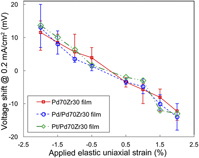Crossref Citations
This article has been cited by the following publications. This list is generated based on data provided by
Crossref.
Francis, M. F.
and
Curtin, W. A.
2017.
Elastic Effects in Adsorbate–Adsorbate Interactions of C and S on a Stepped Ru Surface.
The Journal of Physical Chemistry C,
Vol. 121,
Issue. 31,
p.
16761.
Podjaski, Filip
Weber, Daniel
Zhang, Siyuan
Diehl, Leo
Eger, Roland
Duppel, Viola
Alarcón-Lladó, Esther
Richter, Gunther
Haase, Frederik
Fontcuberta i Morral, Anna
Scheu, Christina
and
Lotsch, Bettina V.
2019.
Rational strain engineering in delafossite oxides for highly efficient hydrogen evolution catalysis in acidic media.
Nature Catalysis,
Vol. 3,
Issue. 1,
p.
55.
Jansonius, Ryan P.
Reid, Lacey M.
Virca, Carolyn N.
and
Berlinguette, Curtis P.
2019.
Strain Engineering Electrocatalysts for Selective CO2 Reduction.
ACS Energy Letters,
Vol. 4,
Issue. 4,
p.
980.
Lin, Jing-Yang
Xi, Cong
Li, Zhe
Feng, Yi
Wu, De-Yao
Dong, Cun-Ku
Yao, Pei
Liu, Hui
and
Du, Xi-Wen
2019.
Lattice-strained palladium nanoparticles as active catalysts for the oxygen reduction reaction.
Chemical Communications,
Vol. 55,
Issue. 21,
p.
3121.
Benson, Eric E.
Ha, Mai-Anh
Gregg, Brian. A.
van de Lagemaat, Jao
Neale, Nathan R.
and
Svedruzic, Drazenka
2019.
Dynamic Tuning of a Thin Film Electrocatalyst by Tensile Strain.
Scientific Reports,
Vol. 9,
Issue. 1,
Perego, Andrea
Giuffredi, Giorgio
Mazzolini, Piero
Colombo, Massimo
Brescia, Rosaria
Prato, Mirko
Sabarirajan, Dinesh C.
Zenyuk, Iryna V.
Bossola, Filippo
Dal Santo, Vladimiro
Casalegno, Andrea
and
Di Fonzo, Fabio
2019.
Hierarchical TiN Nanostructured Thin Film Electrode for Highly Stable PEM Fuel Cells.
ACS Applied Energy Materials,
Vol. 2,
Issue. 3,
p.
1911.
Li, Jinyang
Doubek, Gustavo
McMillon‐Brown, Lyndsey
and
Taylor, André D.
2019.
Recent Advances in Metallic Glass Nanostructures: Synthesis Strategies and Electrocatalytic Applications.
Advanced Materials,
Vol. 31,
Issue. 7,
Zhang, Jiayi
Zhang, Haochen
Cheng, Mu‐Jeng
and
Lu, Qi
2020.
Tailoring the Electrochemical Production of H2O2: Strategies for the Rational Design of High‐Performance Electrocatalysts.
Small,
Vol. 16,
Issue. 15,
Jansonius, Ryan P.
Schauer, Phil A.
Dvorak, David J.
MacLeod, Benjamin P.
Fork, David K.
and
Berlinguette, Curtis P.
2020.
Strain Influences the Hydrogen Evolution Activity and Absorption Capacity of Palladium.
Angewandte Chemie International Edition,
Vol. 59,
Issue. 29,
p.
12192.
Jansonius, Ryan P.
Schauer, Phil A.
Dvorak, David J.
MacLeod, Benjamin P.
Fork, David K.
and
Berlinguette, Curtis P.
2020.
Strain Influences the Hydrogen Evolution Activity and Absorption Capacity of Palladium.
Angewandte Chemie,
Vol. 132,
Issue. 29,
p.
12290.
Alsaç, Elif Pınar
Bodappa, Nataraju
Whittingham, Alexander W. H.
Liu, Yutong
de Lazzari, Adriana
and
Smith, Rodney D. L.
2021.
Structure–property correlations for analysis of heterogeneous electrocatalysts.
Chemical Physics Reviews,
Vol. 2,
Issue. 3,
Cruz-Martínez, Heriberto
Guerra-Cabrera, Wilbert
Flores-Rojas, Ernesto
Ruiz-Villalobos, Dunia
Rojas-Chávez, Hugo
Peña-Castañeda, Yesica A.
and
Medina, Dora I.
2021.
Pt-Free Metal Nanocatalysts for the Oxygen Reduction Reaction Combining Experiment and Theory: An Overview.
Molecules,
Vol. 26,
Issue. 21,
p.
6689.
